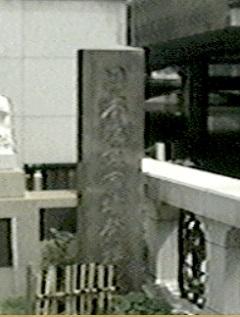It is said that "Edo's specialty samurai bonito daimyo Koji Hirokoji tea shop purple fire extinguisher Nishiki-e fire middle up in a fight against Iseya Inari and a dog's lie."
●Samurai
It seems that there were many samurai in the town of Edo, but "Kidai Shoran" depicts the lives of the common people of Edo, but since there is no memory of samurai also appearing, I will review it again soon .
Kyodai Shoran Nihonbashi
●Bonito
As you know, is it true that "I ate even if I put my kami in quality"?
According to the story of fish, the fish market currently in Tsukiji is in Nihonbashi until the Great Kanto Earthquake, and it seems that it was crowded with being called "Asasen Ryo Fish Bank". By the way, it seems that these are called "Edo 3,000 Ryo" and "Night Senryo Yoshihara". At the foot of Nihonbashi, there is a monument to the origin of the fish market.
 Monuments originating from the Nihonbashi Fish Bank
Monuments originating from the Nihonbashi Fish Bank
●Daimyokoji
It is said that it refers to the area around Marunouchi to Otemachi where there were many daimyo mansions. In this situation, there is an aerial photograph near Tokyo Station in the underground concourse of Mitsukoshimae Station, and if you look at it, the division of the town is clear at a glance. You can clearly see Samurai residence and the town of the townspeople. (Marunouchi side: Daimyoyashiki Yaesu side: townspeople) Please see here along with "Kidai Shoran".
Aerial photograph around Nihonbashi
●Hirokoji
A wide road. I think this path of Hirodai Shoran is one of Hirokoji Temples. In this street, near the Tokaido Ginza, the Hibiya and Tsukiji sides of the street seem to have been reclaimed later and seem to be slightly lower, but I do not understand well in this photo. Look at it with your own eyes.
See the Hibiya area from Ginza 4-chome intersection
See the Tsukiji area from Ginza 4-chome intersection
Continue

